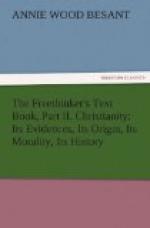The account given by Luke of the meeting of Elizabeth and Mary is clearly mythical, and not historical: “Apart from the intention of the narrator, can it be thought natural that two friends visiting one another should, even in the midst of the most extraordinary occurrences, break forth into long hymns, and that their conversation should entirely lose the character of dialogue, the natural form on such occasions? By a supernatural influence alone could the minds of the two friends be attuned to a state of elevation, so foreign to their every-day life. But if indeed Mary’s hymn is to be understood as the work of the Holy Spirit, it is surprising that a speech emanating immediately from the divine source of inspiration should not be more striking for its originality, but should be so interlarded with reminiscences from the Old Testament, borrowed from the song of praise spoken by the mother of Samuel (1 Sam. ii) under analogous circumstances. Accordingly, we must admit that the compilation of this hymn, consisting of recollections from the Old Testament, was put together in a natural way; but allowing its composition to have been perfectly natural, it cannot be ascribed to the artless Mary, but to him who poetically wrought out the tradition in circulation respecting the scene in question” ("Life of Jesus,” by Strauss, vol. i., pp. 196, 197).
The notes of time given for the birth of Christ are irreconcilable. According to Matthew he is born in the reign of Herod the King: according to Luke, he is born six months after John Baptist, whose birth is referred to the reign of the same monarch; yet in Luke, he is also born at the time of the census, which must have taken place at least ten years later; thus Luke contradicts Matthew, and also contradicts himself. The discrepancies surrounding the birth are not yet complete; passing the curious differences between Matthew and Luke, Matthew knowing nothing about the visit of the shepherds, and Luke nothing of the visit of the Magi, and the consequent slaughter of the babes, we come to a direct conflict between the Evangelists; Matthew informs us that Joseph, Mary, and the child, fled into Egypt from Bethlehem to avoid the wrath of King Herod, and that they were returning to Judaea, when Joseph, hearing that Archelaus was ruling there, turned aside to Galilee, and came and dwelt “in a city called Nazareth.” Luke, on the contrary, says that when the days of Mary’s purification were accomplished they took the child up to Jerusalem, and presented him in the Temple, and then, after this, returned to Galilee, to “their own city, Nazareth.” Moreover, had Herod wanted to find him, he could have taken him at the Temple, where his presentation caused much commotion. In Matthew, the turning into Galilee is clearly a new thing; in Luke, it is returning home; and in Luke there is no space of time wherein the flight into Egypt can by any possibility be inserted. We may add a wonder why Galilee was a safer residence than Judaea, since Antipas, its ruler, was a son of Herod, and would, prima facie, be as dangerous as his brother Archelaus.




